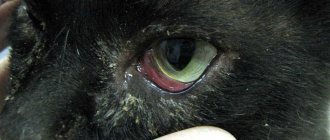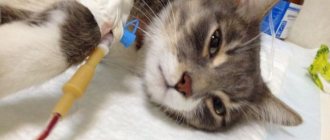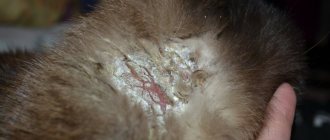Possible causes of itching
The crusts that form on the soft tissues of the animal usually consist of dead particles of the dermis, dried ichor or pus, and coagulated blood.
In color they can be brown, yellow-gray, brown. Let's consider the possible causes of the pathological condition. Blood-sucking insects often accumulate on areas of the body that are most difficult for an animal to reach - on the withers, in the ear area, on the neck. The bites cause itching, inflammation and minor bruising. The cat will scratch the skin, after which traces will remain in the form of dried crusts.
Otodectosis is an ear mite that infects cats, dogs and many other animals. It penetrates deep into the soft tissues of the auditory organs and parasitizes there. A sign of otodectosis is dark crusts in the ears. May be observed: redness, ichor, swelling. If the pet is not treated, the tick leads to severe inflammation and deafness.
The otodeca mite is microscopic and invisible to the human eye. The only symptoms that indicate its parasitism are crusts on the cat’s ears. To confirm the diagnosis, it is necessary to undergo a test. To get rid of otodectosis, drops and special preparations for washing the ears are prescribed.
Allergy
Allergic reactions in a pet can occur to anything - food, dust, household chemicals used in the house, litter tray, etc. Allergic dermatitis appears most often on soft tissues and where the skin is the most delicate and thin. The affected areas become covered with spots, rashes, blisters, and crusts later form in their place. The allergy is accompanied by itching and the cat will scratch the rash.
When an allergy is diagnosed, antihistamines are prescribed. To eliminate external symptoms, ointments and tinctures are used for rubbing. It is very important to remove the allergen immediately, otherwise the treatment will be temporary.
This group includes various lichens and dermatomycoses caused by fungal microorganisms. Some of them are transmitted to people. If a cat has crusts on the tips of the ears, in the shell itself, next to the ear, this is a sign of lichen. Associated symptoms of fungal infections: hair loss, peeling, suppuration or bleeding from affected areas, unpleasant odor. The discharge gradually dries out and forms sores and crusts.
For the treatment of dermatomycosis, fungicidal preparations are used in the form of ointments, liquids, drops. The animal may also be prescribed antifungal medications to take orally. With timely treatment, the prognosis is favorable - the pet recovers quickly and hearing loss does not occur.
In domestic cats that go outside, frostbite and hematomas are the cause of the formation of crusts. A cat's ears are not protected by a lot of fur, and their cartilage is very thin - they quickly freeze in extreme cold. The dead tissue gradually begins to peel off, but first a crust appears.
Having discovered painful signs on your pet’s ears, it is better not to guess about the reasons, but to immediately seek qualified advice.
Any disturbances in the functioning of the animal’s body immediately affect the general condition of the skin and coat. Often, with diseases of the digestive system or other organs, the skin begins to peel, dulls and hair falls out. Ear sores in cats can develop due to a lack of vitamins or minerals in the diet, as well as a decrease in the body's defenses.
In addition, the cause of the development of sores on the face and ears can be infectious or parasitic diseases. Only a qualified veterinarian has the right to determine the exact cause and prescribe appropriate assistance.
At home, trying to help a cat on your own is almost useless, as it may not give results. In addition, advanced infectious bacterial diseases cause serious complications.
The ears of domestic and wild animals are an indicator that signals possible disturbances in the functioning of the cat’s body. In case of allergic reactions caused by changes in diet, contact with household chemicals, and medications, the ears react. The appearance of sores on the ears and head of a cat is provoked by the following reasons:
- diseases of fungal etiology;
- parasitic diseases (otodectosis);
- viral infections;
- diseases of the endocrine system;
- various wounds and scratches;
- malfunctions of the immune system.
Any type of pathology that develops in a cat’s ears has a certain number of characteristic signs. In the presence of accompanying factors, a specific plaque forms on the auricle, causing odor from the auricle. Advanced ear canal infections spread to the tips of the ears and muzzle.
If the cat's face is covered with crusts, and the animal itself looks lethargic, loses its appetite, and tries to sleep more, then in this case it is advisable to suspect disturbances in the functioning of the immune system. A decrease in the body's defenses is accompanied by damage to the skin and coat.
Seborrhea may be present on the skin, the fur may become dull and areas of baldness may form. Skin diseases occur in response to contact with household chemicals and medications. Often the cause of the formation of crusts on the ears and face, as well as ulcerative lesions, are changes in diet and a change in climate zone. The skin of kittens and older animals reacts especially sharply.
The development of sores on a cat’s ears is also provoked by medications whose action is aimed at destroying ectoparasites. Some drugs are quite toxic.
Less commonly diagnosed is solar eczema, which is characterized by specific symptoms - the earlobe is covered with crusts, the coat thins, wounds form on the face, and itching appears.
Sores, itching and the appearance of crusts are also caused by subcutaneous parasites - mites. In veterinary medicine, there are several types of subcutaneous mites that parasitize cats, causing itching and redness. By actively reproducing and gnawing holes in the upper layers of the epidermis, mites provoke a decrease in the body’s immune forces.
Often in the practice of veterinarians there is a fungal infection that affects the face and ears of cats. The specificity of mycoses lies in long-term diagnosis and no less long-term treatment. There is a possibility of healing the cat, but not curing it completely.
This is due to the fact that some fungi are constantly present on the animal’s skin, being opportunistic. When immunity decreases, they begin to actively multiply, provoking inflammatory processes. There are a number of factors that contribute to the development of mallesiosis and candidiasis in cats. These include:
- chronic diseases of internal organs;
- violation of rules for caring for a pet.
With fungal infections, symptoms such as refusal to eat, lethargic general condition of the animal, and constant itching in the ears and face are observed. Crusts with dried blood particles form on the ears. A characteristic feature of a fungal infection is a foul odor emanating from the ear.
Also find out about the possible causes of sores on a cat's neck {amp}gt;{amp}gt;{amp}gt;
Often, a domestic cat often washes and scratches its neck behind the ears, its muzzle, tears the skin on its head and scratches itself so that its hair falls out or sores appear until it bleeds and scabs and scabs, and to find out why this happens and how to treat it, first The first thing you need to do is check whether he has fleas or not. If blood-sucking insects or their eggs are detected, you will need to immediately treat the animal’s fur with special preparations.
Even after the parasites are completely eliminated, the body still contains the substance that entered the bloodstream during the bite. Its effect can last from 1 to 2 months, causing the cat to want to scratch the irritated area.
If no fleas were found during examination of the animal, then the cause of the itching may be as follows:
- skin diseases;
- hormonal disbalance;
- allergic reaction;
- endocrine gland disorder;
- lichen;
- the presence of parasitic worms (helminths).
To eliminate itching and protect a cat living at home from scratching its neck, back and other places, it is necessary to identify the source of its occurrence and carry out effective treatment. Next, the possible causes of the disease are discussed and what to do if the cat often licks itself until it hurts, what to give if it is constantly itching.
Ear diseases in cats
There are several of the most common pathologies of the auricle in cats. In the absence of proper therapy, even due to fungal infection, the animal may lose hearing or die. It is worth considering that some diseases manifest themselves only by the formation of crusts in the absence of any other symptoms.
Allergy
If the cause of the formation of crusts is a food allergy, then the pet needs to be switched to high-quality food and choose a balanced diet. It is important to ensure that the products are fresh and natural. By adjusting the diet, the crusts in the ears of a kitten or adult animal will gradually disappear on their own.
Scabies mite
This pathology is also called otodecosis. It is quickly transmitted from a sick animal to a healthy one and is characterized by damage to the auricle by mites.
With odecosis, the animal's ears are covered with a dark coating with a pungent odor.
The inside of your pet's ears become covered with a dark coating with a pungent odor, and severe itching is observed.
If left untreated, the mite moves deeper and affects the inner ear.
Dermatitis and eczema
Dermatitis is often the result of allergies, eczema, or damage to the animal’s body by parasites. The formation of scabs and wet ulcers, itching, and accumulation of discharge with an unpleasant odor are observed. The disease is not dangerous for healthy cats. Therapy consists of eliminating the root cause and subsequent local treatment of the affected area.
Necrosis of the auricle
- infection of an existing wound on the ear;
- severe injury, prolonged compression of tissue, frostbite, cut;
- spread of the existing purulent process to the auricle.
In the affected organ, blood circulation is disrupted, and tissue begins to rot and die. This is often observed in cats that live outside or spend a lot of time in the cold. The solution to the problem is complete or partial amputation.
Neoplasms
A benign or malignant tumor can form in the purr's ear: papilloma, fibroma, sarcoma. The ear canal is gradually blocked, and the coordination of the animal’s movements is disrupted. Pathology requires surgical intervention.
Hematoma
Occurs as a result of injury, bite, scratching or any other strong mechanical impact. The auricle swells, turns red, and becomes hot. Severe pain syndrome develops. The animal becomes restless and shakes its head. In the clinic, the hematoma is opened and the contents are cleaned out. An ointment is placed inside, for example, “Levomekol”. The procedure is repeated until the symptoms are completely eliminated.
Hematoma occurs as a result of injury
Wounds in a cat's ears indicate a fungal infection. In this case, the formation of small wounds, pimples, blisters with pus or yellow liquid is observed. After they burst, scabs appear.
In this case, you cannot use ointment. At the clinic, a scraping will be taken from the animal to determine the causative agent of the disease and select a drug to which the pathogens are sensitive. To dry the ulcers, Streptocide powder is used.
Inflammatory processes, otitis media
- tick damage;
- formation of neoplasms;
- ear getting wet;
- injury;
- infection.
The main symptoms of damage to the outer ear are itching and excessive production of wax. If the inflammatory process spreads deeper, the pet experiences pain and shakes its head. There is the release of purulent exudate with an unpleasant odor and hyperthermia. The cat's body temperature may rise. The animal is prescribed antibiotics and local treatment of the affected areas.
Lymphextravasate
Can develop as a result of any injury. Characterized by the accumulation of large amounts of lymph under the skin. Lymphatic extravasation does not pose a threat to the life and health of the pet. For a long time there are no external signs of pathology, there is no hyperthermia. As part of the therapy, accumulated lymph is pumped out with a syringe in a veterinary clinic. Sometimes it is necessary to completely open the resulting cavity, after which sutures are applied.
The main symptoms of all ear diseases
Cats, like humans, regularly accumulate small amounts of wax in their ears. This is a natural process that does not lead to pathologies. The cat is a clean creature and usually takes care of its ears on its own. The formation of unhealthy crusts may be accompanied by other manifestations. The following symptoms indicate the disease:
- Clear signs of discomfort in the animal. The cat constantly rubs its head with its paws, shakes it off, tilts it, and turns its muzzle in one direction.
- Atypical discharge from the ears. The secretion has a color and consistency different from ordinary sulfur and smells bad.
- Redness. In addition to discharge, crusts, plaque, the ears become red with signs of inflammation.
- Swelling. The auricles swell in the area of the passage, the tissues practically block the hearing aid.
- Temperature. The cartilage tissue becomes noticeably hot. When healthy, cats have cold ears.
- Itching. The animal scratches its head constantly and for a long time.
- General malaise. The pet looks lethargic, is inactive, eats poorly, and sleeps for a long time.
If the ear is sore, the animal will show discomfort by scratching or pawing at it, shaking or tilting its head towards the painful area.
Other manifestations of ear disease in cats:
- black or yellowish discharge;
- redness or swelling of the ear or ear canal;
- waxing on or near the ear canal;
- bubbles;
- strong smell;
- hearing loss;
- loss of balance or disorientation.
We suggest you read: How to care for a Sphynx cat?
Caring owners can detect the onset of the disease in time by periodically checking the condition of their pet’s ears. An independent attempt to diagnose an animal can lead to progression of the disease. If any alarming signs occur, you should consult a doctor.
The following symptoms indicate the occurrence of pathology:
- Discharge. If there is yellow or brown discharge with a strong odor, you need to clean your pet's ears. If this does not help resolve the problem, you need to contact a veterinary clinic.
- Itching. If your cat scratches its ears more than twice a day, it should be examined.
- Hyperemia. The development of pathology is indicated by redness of the animal's ear.
- Edema. Due to the fact that cats' ears are rarely checked, it is difficult to pay attention to swelling. The reason to see a doctor should be a decrease in the free space in the auricle and the diameter of the ear canal.
- Hyperthermia. As the disease progresses, the ears may become hot.
- "Squish" effect. If an animal's ear is dented, the affected ear will make characteristic squelching sounds.
- Head tilt. When ear disease develops, the pet tilts its head in the direction from which it feels discomfort.
Severe itching is one of the symptoms of ear disease.
Diagnostics
No treatment can begin without diagnostic measures.
Self-medication without a preliminary diagnosis often provokes the development of complications and serious damage to the skin. Veterinary specialists often encounter pyoderma developing on the face and ears of cats due to the lack of timely and adequate treatment.
If you notice itching and the formation of crusts on your pet's ear, it is recommended to contact a veterinary clinic. In a clinical setting, the doctor conducts a clinical examination and collects anamnesis. The necessary studies are prescribed:
- general blood analysis;
- blood biochemistry;
- scraping from the affected area of skin;
- otoscopy;
- serological tests (if allergies are suspected).
Scraping from the affected areas of the skin is mandatory for carrying out bacteriological cultures on nutritious soils. This allows you to identify the pathogen and select a sensitive antibiotic. Advanced cases of damage to the auricle will include radiography, based on the results of which it is possible to diagnose the accumulation of exudate in the ear and the onset of degenerative processes of bone structures.
Itching caused by helminths
There are a large number of varieties of parasitic worms that take up residence in a cat’s body. They can be:
- round;
- flat;
- tape.
Usually at the very beginning of infection it is difficult to consider any of its symptoms, but after a while the animal:
- loses appetite and activity;
- becomes restless;
- Constantly licks and itches.
Worms found in the intestines are considered almost harmless.
Difficulties with your pet’s health arise when there are too many helminths and their larvae begin to migrate.
The movement of worms throughout the animal’s body is accompanied by the following symptoms:
- sudden weight loss, increased fatigue, growth retardation in small pets;
- disheveled wool;
- enlarged liver and icteric staining of visible mucous membranes;
- disruption of the digestive system, expressed in constipation, vomiting, diarrhea;
- appearance of cough;
- discharge from the eyes;
- itching in the anus;
- presence of blood in feces;
- premature birth or miscarriage in cats;
- convulsions and paresis of the limbs.
The cat may not notice the presence of parasites in the body in small quantities. However, their increase will not only exhaust the animal, but will also lead to its death. The harm caused to pets by worms can be completely different:
- eating lymph, tissue and blood;
- release of substances that promote intoxication;
- damage to the mucous membranes by suction cups, leading to internal bleeding.
After the worms die, decomposition products are formed that poison the animal’s body. The appearance of parasites leads to metabolic disorders, as a result of which the cat’s skin becomes dry and dandruff appears on it. Just like an allergic reaction, these factors are accompanied by itching, which causes the animal to scratch its neck until it bleeds.
A pet can become infected with helminths in the following ways:
- eating raw meat or fish (especially river fish);
- flea bites;
- contacts with other animals.
To prevent itching, which causes painful scratching, animal owners need to regularly take a preventive course using anthelmintic medications.
What causes wounds on a cat's neck?
The causes of skin diseases in cats are different, but “uninvited residents”, that is, fleas, can become irritants. To exclude this possibility, you should bathe your pet by treating it with a special shampoo. No flea collars should be worn; they can irritate the skin. If the fleas are removed, but the problems remain, you need to evaluate the general condition of the body. Symptoms of skin diseases in cats at the initial stage are as follows:
- itching;
- red spots inside the ear, in the armpits, in the groin area, on the stomach and neck;
- local hair loss;
- increased separation of scales in the form of dandruff (more noticeable on dark-colored cats);
- peeling of the skin;
- the appearance of weeping;
- various types of rashes.
First of all , if a cat has wounds on the neck, you should think about the pet’s diet. They, like people, are susceptible to food allergies. Congenital predisposition is recorded by veterinary statistics in white cats.
To replenish the supply of vitamins, you need to grow oats in a tray and feed the cat grass.
If your pet constantly eats store-bought food, there is a high probability of disruption of the internal organs. The cat should be switched to natural food: boiled fish (cleaned of bones), fish soup without salt, boiled meat and, as a delicacy, lightly boiled liver (1-2 minutes).
Ringworm and other types of skin mycoses
Ringworm is a skin disease accompanied by:
- the formation of a small rash;
- damage to fur and claws.
This disease can occur due to a viral infection or reduced immunity of the animal.
There are the following factors that contribute to the development of lichen in pets living at home:
- walking outside without supervision;
- treatment with immunosuppressants;
- malnutrition;
- parasite infection;
- malignant formations.
The most common causes of ringworm in cats are those caused by fungal infections. There are several types of lichen:
- Ringworm, which is based on fungal diseases. This type is easily transmitted to humans, especially to young children. Fungal spores remain viable for 5-10 years because they are resistant to environmental influences.
- Versicolor or pityriasis versicolor, which is a dangerous disease. The cause of its occurrence is a yeast-like fungus, which under certain conditions transforms into a pathogenic form.
- A shingles or pink appearance that appears when immunity is reduced and is of an allergic nature.
- Eczema or tinea versicolor manifests itself in animals as an allergic reaction to a specific irritant and is not transmitted through contact with humans or other animals. Allergies can be caused by exposure to household chemicals, a malfunction within the body, or stress.
All types of lichen in cats have common symptoms:
- hair loss;
- inflammation of the skin accompanied by peeling;
- change in pigmentation;
- severe scabies.
If you suspect lichen, the cat should be isolated immediately. A glazed balcony, loggia or separate room is suitable for this; you need to make sure that the room is warm. After this, you need to contact a veterinarian to establish through diagnostics the cause of the cat’s itching and methods of treating it.
To prevent such diseases from occurring in cats, it is recommended to periodically vaccinate them for preventive purposes.
It is a real problem that is quite difficult to get rid of. The fact is that lichen can be transmitted with extraordinary speed, affecting the head, paws and spine of the animal. Also, it easily clings to humans, which is due to the fungal nature of this disease.
In the first stages, getting rid of microsporia is quite easy. The main goal is to identify and make the correct diagnosis in time. You should prevent the fungus from infecting most of the skin. As it spreads, lichen can become painful and cause discomfort and discomfort in the cat.
Fungal diseases in cats are often caused by a moldy fungus called dermatophyte. Depending on the type of bacteria, microsporia progresses with some differences, but the symptoms and course of the disease remain the same.
This disease is dangerous exclusively for cats, kittens, children and adults. It does not affect only dogs and birds. Therefore, having discovered it, it will not be harmful for all family members to undergo preventive measures.
Fungal infections rarely lead to erosive and ulcerative skin lesions in cats. Candidiasis of the mucocutaneous areas is a rare cause of erosion associated with wet maceration of the skin. However, the defeat of Candida spp. must be taken into account in the differential diagnosis of eosinophilic ulcers in the lip area in cats, because
Dermatophytosis does not often lead to the development of erosions and ulcers, but excoriation, especially in kittens, can manifest itself as erosions in the head area (photo 8). Rare cases of pseudomycetoma in the area of the body and base of the tail in Persians also manifest themselves as ulcerated nodules on the skin.
Treatment is carried out comprehensively, combining the local use of drugs (for example, povidone-iodine) and eliminating the causes of mycosis. In the absence of improvement and/or generalization of lesions, systemic antimycotic therapy is used (intraconazole po 10-20 mg/kg every 24-48 hours, ketoconazole 5-10 mg/kg every 12-24 hours).
We invite you to familiarize yourself with the main reasons why urine smells like ammonia in women, men and children
Treating scratches at home
If a cat scratches itself until it bleeds, the first step is to treat the wound so that it does not get infected. Regular human ointments are suitable for this.
To avoid further scratching of the skin, the cat should trim its claws and cover the problem area with something (for example, put a special collar or vest on the animal).
If a doctor has diagnosed lichen, the sick animal must be isolated from healthy ones. The fur next to the affected area is shaved off. The affected area is treated with ointments.
If an animal is taking any anti-inflammatory or immunosuppressive drugs, they should be stopped for a while so that the body has the strength to cope with the fungus.
The room in which the cat lives, as well as all objects with which it comes into contact, must be disinfected. Treatment of lichen can take quite a long time, but if its initial stages are detected, the animal will fully recover.
A special diet will help overcome food allergies. A product that causes a negative reaction should be excluded from the diet. You can also purchase commercial food for cats prone to allergies.
Atopic dermatitis can also cause itching. This is also an allergic reaction of the cat’s body, but it is impossible to isolate the exact allergen and completely eliminate it. Atopic dermatitis cannot be cured, but with the help of medications, all negative manifestations of allergies can be eliminated.
If a cat is suffering from a bacterial infection, the first step is to use various ointments. If an animal develops ulcers, the doctor will prescribe a course of antibiotics.
If the disease becomes chronic, the veterinarian takes microbiological tests. This is necessary to prescribe the most effective treatment for this type of bacteria.
When do you need veterinary help?
Often, scratching is almost harmless and does not cause the animal much discomfort. The owner may not even immediately notice that something is wrong with the pet. Problems begin when bacteria get into the wound. In this case, an abscess may form on the skin. In some cases, without timely treatment, the area of scratching may increase.
You might be interested in: Why does a lump appear near a cat’s nipple?
If an animal scratches a small wound once, there is no need to sound the alarm. Perhaps the cat just overdid it. The wound should be treated and the pet should be monitored.
In what cases should you take your pet to the veterinarian:
- The cat scratches the same place for a long time until it bleeds.
- The area of scratching increases.
- The wound oozes pus or does not heal.
- Scabs form on the affected area of the skin.
- The cat's hair falls out and bald patches form.
- The animal is constantly itching.
Scratching is often one of the symptoms indicating that the animal is unhealthy. In this case, you should pay attention to the general condition of the cat. You should contact your veterinarian if the following symptoms accompany itching:
- Decreased activity or excessive agitation.
- Increased body temperature.
- Lack of appetite.
- Nausea, vomiting, diarrhea.
Diagnostic methods
Cat ears are sensitive to infections and should always be handled with care. Your four-legged friend's ears should always be clean and free of thick brown or green waxy discharge. There should be no redness, itching or unusual odors. Be sure to ask your veterinarian to check your ears during routine checkups.
Some problems can be dealt with at home by first consulting a veterinarian.
Ear fungus
If the infection is localized to the skin, medicated shampoos are prescribed to soothe the skin and eliminate odors. Antifungal medications are also prescribed to reduce the amount of fungus and bacteria. Medicinal ointment with insecticides is effective.
The fungus affects not only the inner, but also the outer part of the ear
In severe cases, the doctor will prescribe steroid injections, depending on the cat's condition.
The lesions are characterized by thick crusts and plaques that can collapse or form again. Secondary bacterial and fungal infections aggravate the condition. In some cases, it goes away spontaneously, but only after 12–24 months. Therapy with topical tacrolimus or oral cyclosporine at a dose of 5 mg/kg/day is effective.
Dermatitis and eczema
In some cats, the inner, hairless part of the ear becomes inflamed and irritated after using certain ointments or medications. This inflammation, called contact dermatitis, can develop 1 to 7 days after the reaction begins. The skin of the abalone becomes red and swollen, and crusts or ulcers appear.
Cool baths, medicated shampoos and conditioners, and calming sprays can help your pet. Mild allergies are treated with antihistamines or omega-3 fatty acids.
Hematomas and abscesses
You need to carefully cut off as much hair as possible from the painful area in order to better see the size of the wound. Then clean and apply hydrogen peroxide to the wound to disinfect.
Important! Do not use alcohol or antibiotic ointments for an abscess. The alcohol burns, but she will lick the ointment.
With this disease, the cat's ears become wet. Signs of ear mites include excessive skin scratching, head shaking, a strong odor, and dark discharge. Before using the medicine, you need to rinse and clear the black waxy deposits and dirt from the ear canal. Drug treatment usually uses topical drops containing a pyrethrin insecticide.
Ticks not only cause discomfort, but also carry infections.
Apple cider vinegar is allowed to be used as a natural remedy. You need to mix it with warm water and treat the wounds for several days.
Sometimes the middle and inner parts of the ear become infected. This occurs either because the outer ear infection has moved deeper into the ear or because the bacteria has spread through the bloodstream or eustachian tube. If a cat has wet ears inside, this is the first symptom.
Important! For first aid, homemade antiseptics are used: furatsilin, peroxide, boric acid.
Malassezia is part of the normal flora of the skin, ears, and mouth. Has a symbiotic relationship with staphylococcus. Topical therapy usually focuses on the use of shampoo, however there is a newer product (Douxo Chlorhexidine PS with alpazole).
The systemic drug of choice for cats is itraconazole 3–5 mg/kg orally once daily for 15–30 days. Typically, dramatic improvement occurs within 7-10 days.
Not every growth on a cat's ear will be cancerous, but should be checked by a veterinarian. Older cats and those with white ears and heads are especially susceptible to skin cancer. A biopsy is required to confirm the diagnosis.
If you see a large piece of grass or something else in your ear that shouldn't be there, you should try to carefully pull it out with your fingers or tweezers. If resistance is felt or the cat appears uncomfortable, stop immediately and call your veterinarian. The doctor will calm the cat, safely remove the foreign body, examine it for damage, and prescribe medications for healing.
Regular inspection and cleaning will help avoid many troubles.
The main manifestation of a hematoma is swelling of the outer area of the ear. The condition usually occurs in only one ear. The animal will show pain, shake its head, and may tilt its head to one side.
A clear sign of hematoma is asymmetry and swelling
Surgery is the most common treatment for hematoma. The cat is placed under anesthesia and a small incision is made on the bottom of the ear. The fluid drains out and stitches are placed in the affected area. They are removed after 2-3 weeks.
A sore in a cat’s ear requires determining the cause of its occurrence. Pain relievers, anti-inflammatory medications, antibiotics, and antifungal medications are just a few treatment options your veterinarian may recommend for a cat with skin ulceration.
Advice! To provide first aid, you can anoint the rim of the sore with Levomekol.
Sulfur plugs
For treatment, disinfectants are used, for example, 3% boric acid solution, hydrogen peroxide, chlorhexidine solution. It is convenient to treat ears with special care devices (manufacturer names: Bars, Otoklin, Rosinka, Leo Cat Cleaner, Otifree and Hartz). Specialized products help to more effectively dissolve deposits and sulfur impurities, do not irritate the pet’s delicate skin and are hypoallergenic substances.
Chronic otitis media is a long-term infection. Therapy begins with cleansing and the use of medications such as antimicrobials and anti-inflammatory drugs. Corticosteroids are sometimes used to reduce pain, redness, and swelling.
Attention! Diagnosis of the underlying disease is necessary. Ear diseases in cats can be treated with medication, although sometimes surgery may be the only option.
Treatment of sores on the ears and face of a cat requires an integrated approach based on research results. Depending on the type of pathological process and the cause that caused it, the veterinarian develops an individual scheme.
Crusts and ulcers formed on the ears and face as a result of an allergic reaction should be treated by eliminating the provoking factor. So, in case of nutritional allergies caused by improper feed or products, a replacement diet is carried out. The specialist selects the food and observes the body’s reaction.
If the cause of the allergy is contact with household chemicals, it is necessary to eliminate the allergen from everyday life. As a rule, after eliminating the underlying factor of the allergy, the body copes on its own and the skin is restored.
The addition of pathogenic bacterial microflora implies the use of antibiotics. The duration of the course and the type of drug are selected by the doctor, taking into account the patient’s age, weight and body characteristics.
Treating ulcers on a cat’s face and ears is quite problematic, since the animal often licks external medications (ointments and liniments) that are applied to disinfect wounds and eliminate pathogenic microflora. During the entire course of therapy, the owner is recommended to purchase a special collar to put on the animal so that it does not reach the treated areas. If your cat feels discomfort and refuses to eat with the collar around its neck, you can remove it while eating.
The resulting sores on the skin, provoked by subcutaneous mites (sarcoptosis or demodicosis), are treated comprehensively. In addition to specific medications, therapy necessarily includes taking immunomodulating agents and vitamin complexes. This is due to the fact that with a normal level of immunity, the animal’s body is able to cope with the disease on its own.
Therapy begins only after the animal is diagnosed. A correct diagnosis improves the effectiveness of therapy. Independent attempts to get rid of diseases can only worsen the condition and cause an exacerbation of the disease.
It is strictly forbidden to clean cats' ears using hygiene sticks. Discharge and dirt can only be removed with cotton pads. If the doctor insists on surgical treatment, there is no need to refuse. It may be the only effective method of getting rid of pathology.
To choose the right treatment, you need to accurately determine the diagnosis. The following methods are used for this:
- general examination;
- scraping;
- microbiological study of hair roots during the formation of bald patches;
- general and biochemical blood test;
- Ultrasound, x-ray if the formation of a neoplasm is suspected.
How to treat a cat's wound
Every owner should know how to treat an open wound on a cat, since the damage is sometimes dangerous.
Furacilin solution
This product actively counteracts microbes and prevents their proliferation. It can be used on any type of wound. The product can be purchased at a pharmacy or made independently from several tablets. It is necessary to treat the wound with a napkin soaked in the solution, or by securing a bandage to the surface.
Important! Furacilin can cause allergic reactions in a kitten, so you should stop using the product if you are hypersensitive.
Hydrogen peroxide
Many owners are interested in the question of what to do when a cat hurts its paw, what to treat from the home first aid kit, and how often to do it.
In this case, hydrogen peroxide will help, which is used to treat wounds and stop bleeding. Moisten cotton wool or a napkin with the product and apply it to the affected area. The product is recommended to be used even in the presence of pus.
It is necessary to wash the wound with peroxide until it stops foaming. It is the foam that indicates the presence of dirt in the damaged area.
Baneocin ointment
This drug is used to treat both small wounds and purulent lesions. The composition includes an antibiotic that relieves inflammation, kills germs and promotes healing. The ointment is not addictive, so it is used 3-4 times a day. The course of treatment should not exceed 14 days. Otherwise, you can provoke a fungal infection.
Important! Baneocin is not advisable to use in the treatment of cats with liver and kidney failure.
Levomekol ointment
A popular ointment for cats for wound healing is Levomekol. Has a good antimicrobial and anti-inflammatory effect. Used for recovery after surgery, as well as in the treatment of various open wounds. The antiseptic effect has a positive effect on purulent wounds and inflammatory processes in tissues.
Advice! You can apply the ointment to the surface of the injury or place napkins soaked in the preparation inside.
Use the ointment for about 10 days, during which time all the pus should come out of the wound
Infectious skin diseases
Skin diseases are the most common problems causing problems for cats and their owners. Most often, this affects pets that occasionally walk outside.
Diseases caused by bacterial infections occur in two forms, such as:
- dry, accompanied by the formation of dry scaly plates and crusts;
- wet, expressed in the appearance of ulcers and blisters filled with exudate.
We invite you to familiarize yourself with the Burmese cat photo description of the breed
Cats that have suffered serious illnesses, as well as surgical operations, remain immobile for some time, as a result of which they develop bedsores. Tissue necrosis occurs in areas of prolonged contact of the skin with the litter. To prevent this, the animal must be turned over as often as possible, and places where bedsores may form should be wiped with camphor alcohol or disinfectants.
Cats with hypersensitive skin are at risk of developing eczema. The reasons for its occurrence may be different:
- skin damage due to prolonged friction from contact with any object (collars, harnesses, etc.), due to burns and parasite bites;
- consequences of internal disorders in the body (neuropathy): hormonal imbalance, diabetes.
With eczema, the animal's skin develops rashes and blisters. There is a constant itching sensation in the affected areas (including the neck). To treat this disease, various ointments, soothing powders, and antibiotics are used.
A common disease among cats is acne (blackheads). Its cause may be the animal's low immunity, being under stress or improper care. This bacterial infection has a detrimental effect on the sebaceous glands. As a rule, its presence is indicated by rashes in the form of ulcers throughout the animal’s body. The largest accumulation of acne occurs on the cat's chin, neck and lip area.
At the beginning of treatment, the skin is first treated with antiseptic detergents.
The main reasons for the appearance of a lump behind a cat's ear
The most common reason is cat fights.
With the onset of spring, many cats get into fights to attract the attention of the opposite sex or to establish the boundaries of their territory. As a result, combatants have lacerated ears, claw wounds, and swelling on the face or ears.
If your pet does not walk outside, diseases can lead to tumors behind the ears. Among them are both dangerous and easily treatable.
Abscess
Translated from Latin, it literally means “abscess.” This is an inflammatory disease in which a cavity is formed filled with purulent contents. The formation of a lump leads to the development of a deep abscess. In this case, muscle tissue and subcutaneous fat are affected. Among the main signs of the disease are:
- Redness . Its appearance indicates that an inflammatory process has begun in the animal’s body.
- Edema . The lesion begins to rise above the surface of the skin and increases in size.
- Fluctuation (filling with pus) . This stage is characterized by the presence of purulent contents. On palpation, it flows from one edge of the cavity to the other.
Consequences. With good immunity in the mustachioed-striped, the disease most often ends in an outpouring of pus. In more severe cases, gangrene or phlegmon may begin to develop.
Therapy. All treatment boils down to opening the abscess and removing the pus. In more severe cases, surgical excision of necrotic tissue is performed. After opening, the abscess is washed with antiseptic solutions, drainage is installed in the wound and stitches are applied. Subsequent treatment is with antibiotics and continues for a week.
Phlegmon
It can be either an independent disease or a complication of an abscess or carbuncle. Most often caused by Staphylococcus aureus and characterized by putrefactive or purulent inflammation of fatty tissue. The difference between phlegmon and other inflammatory processes is the absence of clear boundaries.
Therapy. Treatment is carried out by opening and removing the contents. After cleansing the cavity, apply a bandage to the wound using fatty ointments:
- Vaselinova;
- Vishnevsky;
- Sintomycinova;
- Tetracycline.
If there are signs of necrosis (tissue death), necrolytic agents (for example, trypsin) or enzyme-containing ointments are prescribed to accelerate the process of rejection of the affected tissue.
Otodectosis
The disease is caused by tiny parasitic insects.
When infected with ear mites, the animal begins to shake its head and scratch its ears.
If an infection gets into the wounds, swelling soon begins and an abscess or phlegmon develops. Otodectosis often ends in death. Treatment should primarily be aimed at combating the ear parasite. After recovery, the lump on the ear can be removed surgically.
Enlarged lymph nodes
Compaction and enlargement of lymph nodes are typical for:
- Lymphadenitis, which is caused by various viruses and bacteria.
- Malignant neoplasms that metastasize to the lymph nodes.
Lymphadenitis is characterized by high fever, apathy and decreased appetite. But the disease is not so dangerous, and after eliminating the cause of inflammation, the lymph nodes return to their previous size.
Papillomavirus
Common warts are often mistaken for bumps. Their formation is due to the presence of the papilloma virus in the cat’s body.
For this disease, treatment is aimed at increasing the animal’s immunity. If the type of virus is oncogenic, it is recommended to remove them and vaccinate the cat with a special antiviral vaccine.
For any swelling or bumps that appear behind the ear, the cat should be shown to a veterinarian, since the reasons for their appearance may not always be as harmless as the consequences of “fighting”. It is the timely detection of diseases that will help maintain the health of your furry pet.
Anatomy of the ears of cats and cats
The ear is the organ of hearing and balance. It consists of outer, middle and inner.
The outer ear includes the pinna (the visible part of cartilage covered by skin, fur, or hair) and the ear canal. The ear canals of cats and kittens are deeper and more conical than those of humans. This deeper canal is prone to the accumulation of dirt and wax, leading to inflammation and secondary infections.
Cats' hearing is many times more sensitive than humans'.
The middle consists of the eardrum and an air-filled chamber that contains 3 tiny bones, 2 muscles, the oval window and the eustachian tube.
The inner ear is a complex structure that includes the cochlea (the organ of hearing) and the vestibular system (the organ of balance).
Anatomy of a cat's ear
Infestation by exogenous insects
. The presence of these insects leads to the occurrence of various diseases. The most dangerous of them include:
- flea dermatitis;
- mite damage: sarcoptic mange, notoedrosis.
When a flea bites, a wound with their saliva remains on the animal's body, causing severe itching. The cat begins to vigorously scratch the affected area, which leads to the infection getting inside. The inflammatory process in combed areas is manifested by redness and hair loss.
Fleas not only contribute to the occurrence of infectious diseases, but are also carriers of worm eggs (helminths).
When infected with ticks, the clinical picture in cats is as follows:
- severe itching on dry areas of the skin;
- hair loss;
- formation of ulcers on exposed areas.
Notoedrosis in cats is manifested by the presence of Notoedres cat mites and is accompanied by the following symptoms:
- itching and severe scratching;
- rash in the form of blisters;
- the appearance of crusts on itchy areas;
- hair loss;
- loss of skin elasticity, appearance of cracks infected with bacteria and fungi.
. These tiny bloodsuckers are 0.2-0.4 mm long and have a long proboscis. Thanks to this, they easily gnaw holes in the skin and make a large number of moves in it. Once on the animal's body, the parasites begin to actively lay larvae. In this regard, already 1.5 months after their appearance, their numerous offspring are present on the cat’s body.
The main symptom of this disease is severe itching, which gets worse in the evening. First of all, the tick infects areas on the animal’s head, neck, and near the ears, where blisters and redness immediately appear. After a while, these places become covered with dried crusts. The animal becomes restless, constantly itches and meows. Constantly scratching itchy areas, the cat cannot sleep, loses its appetite and experiences weight loss.
Therapy involves not only getting rid of bloodsuckers, but also healing damaged skin areas, as well as restoring the pet’s immune system.
Important! At the first signs of sarcoptic mange, the cat should be shown to a specialist.
What treatment is prescribed?
When the diagnosis becomes known, a comprehensive treatment regimen is prescribed. For allergies and itching, the doctor will prescribe antihistamines and anti-inflammatory drugs, but in addition, it is important to identify the source of the pathological reaction and try to eliminate it. If inflammation and suppuration are noticeable on the sore, antibiotics are used. You can smear the affected areas with antibacterial ointments prescribed by your doctor, and if the disease is advanced, you will need an injection of the drug.
If skin parasites are found, you need to treat the cat's fur with special antiparasitic agents, and also carry out deworming at the same time. If a plaque formed on the head is a symptom of a fungal infection, the doctor will advise you to anoint the affected area with an antifungal agent. For acne, specialists at the Zoostatus clinic advise treating the affected areas with Miramistin or Chlorhexidine solutions. Antiparasitic injections will help get rid of ticks, as well as treating inflamed areas with special lotions and powders.
Allergic reactions
Allergies in pets occur due to an inadequate reaction of the body to substances that enter the body from the environment. This could be dust, pollen, one or more components in food, etc. The disease is usually accompanied by:
- severe itching (especially in the head and neck area);
- increased body temperature;
- hyperemia and hair loss.
Long-term exposure to an allergen leads to the development of asthmatic syndrome, atopic dermatitis and the formation of granulomas containing a large number of eosinophilic leukocytes.
An animal with similar symptoms should be shown to a specialist for the purpose of diagnosis and treatment for itching.
If a cat begins to actively scratch its neck, the owner needs to find out the cause of such discomfort as quickly as possible. Serious skin lesions should warrant a visit to the veterinarian. In most cases, skin diseases in cats do not pose a serious threat to their lives, and they can be treated at home.
Many breeders associate the word “allergy” with a runny nose, watery eyes and other minor troubles. This is partly true, but allergic reactions in practice are much more dangerous. In particular, they are considered the main cause of incurable and deadly diseases, but even in “moderate” cases of pathology, these pathologies can cause a lot of trouble.
Dermatitis is a pathology accompanied by inflammation of the skin. Accordingly, in this case, the inflammation is caused by a serious allergic reaction.
Firstly, the latter leads to a catastrophic weakening of the skin’s protective mechanisms, which is why it can no longer resist the action of pathogenic and conditionally pathogenic microflora.
Secondly, a much worse option is possible: due to increased vascular permeability, lymphocytes begin to migrate en masse into the thickness of the epithelium. This effect is called lymphocytic or neutrophil infiltration and, by the way, it often leads to the development of autoimmune inflammation. Stress factors accelerate and intensify the pathological process.
Preventive measures
The best way to prevent a painful ear infection is to have your pet checked and examined regularly.
Tips for a cat owner:
- Minimize the amount of time your cat (especially if she is white or lightly pigmented) is exposed to direct sunlight, for example by sitting in a window.
- Keeping the area clean will help prevent the spread of ear mites and other potentially infectious agents.
- Check your pet regularly for infections, swelling, and discharge.
- Consult a veterinarian when the first symptoms of the disease appear.
Fortunately, ear diseases in cats are easy to treat with proper diagnosis and prompt treatment. It’s worth asking your veterinarian to show you exactly how to check and clean your four-legged friend’s ears. Healthy ears are pale pink, with no visible debris or odor, with minimal or no ear wax. Keeping your skin dry will help prevent infections.











